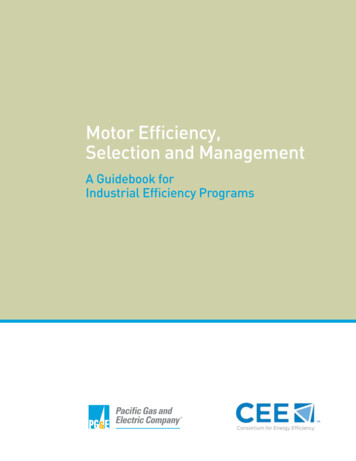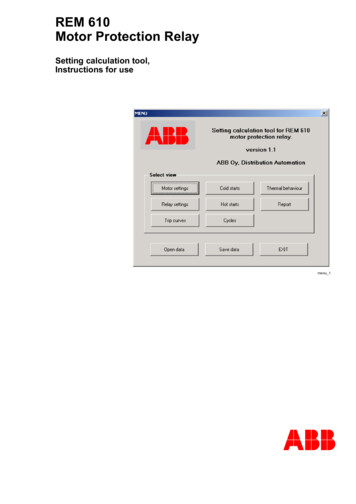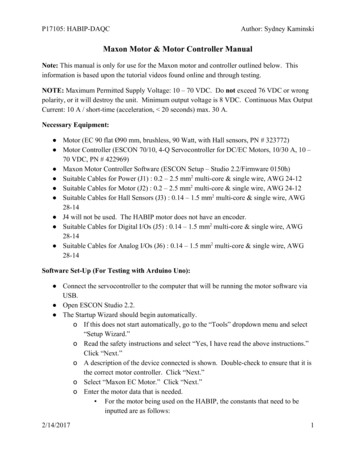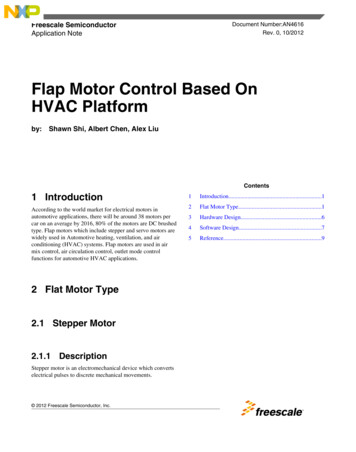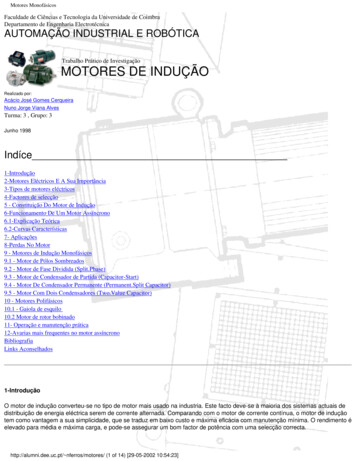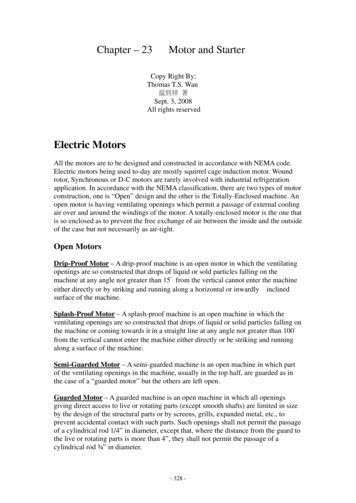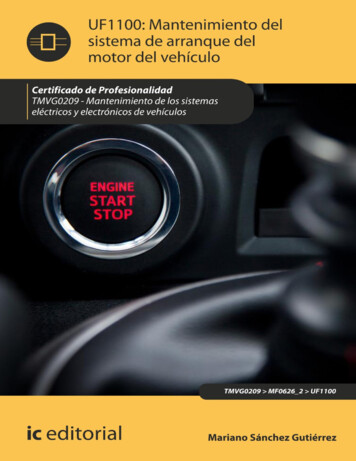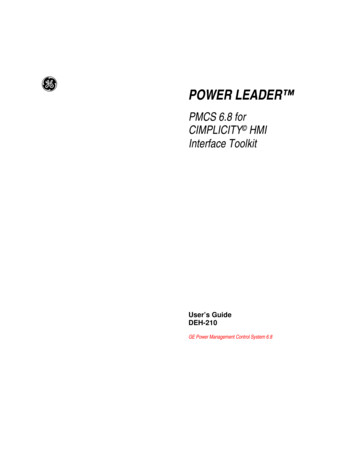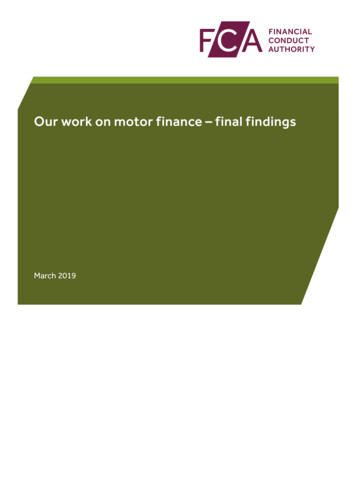
Transcription
Our work on motor finance – final findingsMarch 2019
Search Financial Conduct AuthorityOur work on motor finance – final findings361217192122How to navigate this documentreturns you to the contents listtakes you to helpful abbreviationstakes you to the previous pagetakes you to the next pageprints documentemail and share document2
SearchFinancial Conduct AuthorityOur work on motor finance – final findings Section 11Introduction1.1In April 2017, we announced in our Business Plan for 2017/18 a review of the motorfinance sector. We wanted to understand the use of motor finance products, and toassess the sales processes employed by firms and whether the products could causeconsumer harm. For example, this could be because the finance is ancillary to theacquisition of a vehicle, and so may be a secondary consideration for the consumer.1.2In July 2017, we set out some key questions for the review to answer: Are firms taking the right steps to ensure that they lend responsibly, in particularby appropriately assessing whether potential customers can afford the product inquestion?Are there conflicts of interest arising from commission arrangements betweenlenders and dealers and, if so, are these appropriately managed to avoid harm toconsumers?Is the information provided to potential customers by firms sufficiently clear andtransparent, so that they can understand the risks involved and make informeddecisions?Are firms managing the risk that asset valuations could fall and ensuring that theyare adequately pricing risk?1.3In March 2018, we published an update report setting out what we had done and ourinitial findings. We also described the further work we would be undertaking.1.4Our initial findings included the following: 1.5The motor finance sector had continued to grow, particularly for personal contractpurchase (PCP, a form of hire-purchase with lower monthly instalments and a finalballoon payment linked to the residual value of the vehicle).The largest lenders were adequately managing the prudential risks from a potentialsevere fall in used car values, but firms should regularly consider relevant changes inthe market.Growth in motor finance had been strongest for lower credit risk consumers (highercredit scores), who are less likely to face repayment difficulties.Arrears and default rates generally remained low, but had increased somewhat,particularly for higher credit risk consumers (lower credit scores), despite relativelybenign credit and macro-economic conditions.If not properly managed, some of the commission arrangements in place couldprovide incentives for dealers to arrange finance at higher interest rates.In some cases, information to consumers on websites and in contractdocumentation was not sufficiently prominent or easy to understand.We committed to focusing in the remainder of our review on the issues of greatestpotential harm to consumers. These included: Whether lenders are adequately managing the risks around commissionarrangements, and whether commission structures have led to higher financecosts for customers because of the incentives they create for brokers.3
SearchFinancial Conduct AuthorityOur work on motor finance – final findings Section 1 Whether customers are being given the right kind of information, at the right times,to enable them to make informed decisions, and whether firms are complying withrelevant regulatory requirements.Whether firms are properly assessing whether customers can afford to repay thecredit, particularly when lending to higher-risk consumers.1.6Our follow-up work included an analysis of loan data collected from 20 motor financeproviders, a mystery shop exercise and a survey of lenders that looked at how theyassess affordability and exercise control over their credit brokers.1.7Our key findings are set out in the following chapters, and summarised below.Executive summaryCommission arrangements 124We are concerned that the way commission arrangements are operating in motorfinance may be leading to consumer harm on a potentially significant scale.Some customers are paying significantly more for their motor finance because ofthe way lenders choose to remunerate their brokers.In particular, we are concerned about the widespread use of commission modelswhich link the broker commission to the customer interest rate and allow brokerswide discretion to set the interest rate. This gives rise to conflicts of interest andcreates strong incentives for the broker to charge a higher interest rate.We found that these incentives have significant effects on the cost of motorfinance for consumers, even after controlling for other factors which might affectinterest costs, such as the customer’s credit score, loan value or length of theagreement. For commission models where the broker has discretion over theinterest rate, increases in broker commission are associated with higher increasesin interest rates, particularly for difference in charges (DiC) models.1Across the firms in our analysis (around 60% of the market) we estimate thatcommission models which allow broker discretion over the interest rate couldbe costing customers 300m more annually when compared against a baselineof Flat Fee models.2 We estimate that on a typical motor finance agreement of 10,000, higher broker commission under the Reducing DiC model can result in thecustomer paying around 1,100 more in interest charges over the four-year termof the agreement.It is not clear to us why brokers should have such wide discretion to set or adjustinterest rates, to earn more commission, and we are concerned that lenders are notdoing enough to monitor and reduce the risk of harm.Such commission arrangements can also break the link that might otherwise beexpected between credit risk and the customer interest rate. This can impact onpricing and affordability for individual customers.We consider that change is needed across the market, to address the potentialharm we have identified. We have started work with a view to assessing the optionsfor policy intervention. Subject to analysis of the costs and benefits of potentialThe different commission models are explained in paragraph 2.3 below and the associated footnotes.See paragraphs 2.14-2.17 below.
SearchFinancial Conduct AuthorityOur work on motor finance – final findings Section 1interventions, this could involve consulting on changes to our consumer credit rulesto strengthen existing provisions or other policy interventions such as banning DiCand similar commission models or limiting broker discretion.Sufficient, timely and transparent information Our mystery shopping results raised a number of concerns in relation to precontractual disclosure and explanations, and we are not satisfied that firms arecomplying with regulatory requirements. We will follow up with individual firms.While it is possible that disclosures may have been made later in the process (notcovered in our mystery shopping exercise), it is unclear whether this would be ingood time before entry into an agreement, to enable the customer to make aninformed decision.Where disclosures or explanations were given, these were not always complete,clear or easy to understand. As a result, customers may not be given sufficientinformation and explanation to enable informed decisions.We have particular concerns in relation to disclosure of commission, especially inrespect of DiC and similar commission models where the broker has discretion toadjust the interest rate. There are existing requirements in our Consumer Creditsourcebook (CONC) on disclosure of brokers’ status and remuneration, but we didnot see clear evidence of compliance with these.In particular, brokers must disclose the existence of any commission or otherfinancial arrangement with a lender which could affect the broker’s impartiality inpromoting a particular product or impact on the customer’s decision-making. Suchdisclosure should be clear and readily comprehensible. In addition, the broker mustdisclose the amount (or likely amount) upon request.Lenders also have obligations in this area. In particular, CONC 1.2.2R requireslenders to take reasonable steps to ensure that persons acting on their behalfcomply with CONC. This includes compliance with rules relating to disclosure ofcommission. However, while in principle the way lenders told us they frame theircontrols appeared broadly reasonable, we have doubts as to whether and to whatextent these are always implemented in practice. Our work suggests that somelenders may be unduly reliant on contractual requirements and the provision ofstandard documentation and procedures, and may not monitor brokers sufficientlyclosely or act where issues are found. We were particularly concerned that somelenders appear to take the view that it is sufficient that a broker is FCA-authorised,as it can be assumed that they will be compliant with FCA rules (as the FCA willmonitor compliance).Firms should review their policies, procedures and controls to ensure they arecomplying with all relevant regulatory requirements and are treating customersfairly.Affordability assessment We are not satisfied that all lenders we surveyed were complying with FCA rules onassessing creditworthiness, including affordability. Some seemed to focus undulyon credit risk (to the lender) rather than affordability (for the borrower), and therewere gaps or anomalies in information provided.We introduced new rules and guidance last July, which came into force on 1November 2018. We expect firms to have reviewed their policies and procedures, inlight of these, and made changes where necessary. We will follow up with individualfirms to check this has been done.5
SearchFinancial Conduct AuthorityOur work on motor finance – final findings Section 222.1Commission structuresThe question we set initially was:Are there conflicts of interest arising from commissionarrangements between lenders and dealers and, if so,are these appropriately managed to avoid harm toconsumers?2.22.3We wanted to understand the different commission structures between lenders anddealers (and other credit brokers) and the incentives these may create. In particular,we wanted to assess whether they give rise to conflicts of interest which could lead tohigher finance charges for customers.Commission arrangementsIn the first phase of our work, we analysed contracts between some of the largestlenders (accounting for around 45% of the motor finance market) and their top dealers,covering the period 2013 to 2016. There were 4 main types of commission structureused in the sample of contracts we reviewed – Increasing Difference in Charges(Increasing DiC)3, Reducing Difference in Charges (Reducing DiC)4, Scaled Commission(Scaled)5 and Flat Fee Commission (Flat Fee).62.4We found that Increasing DiC and Reducing DiC commission arrangements canprovide strong incentives for brokers to arrange finance at higher interest rates. This isbecause the amount of commission increases with the interest rate that the consumeris charged. In these cases, the broker has discretion to set the interest rate payableby the customer, within parameters set by the lender. Other commission structuresprovide a weaker link to the interest rate or none at all.2.5In the final phase of our work (since March 2018), we collected data from lendersto assess whether commission arrangements have led to higher finance costs forcustomers. This involved a sample of around 1,000 motor finance agreements from20 lenders representing about 60% of the market. These covered January 2017 to July2018 and represented a range of customers with different credit risk profiles.72.6The sample covered a range of brokers, including franchised dealers, independentdealers and online brokers. The commission models mentioned above featured in over95% of the agreements in our sample.345676Also known as ‘Interest Rate Upward Adjustment’. Brokers are paid a fee which is linked to the interest rate payable by the customer.The contract between the lender and the broker sets a minimum interest rate, and the fee is a proportion of the difference ininterest charges between the actual interest rate and the minimum interest rate.Also known as ‘Interest Rate Downward Adjustment’. This is similar to Increasing DiC, except that the contract between the lenderand the broker sets a maximum interest rate.Also known as a variable product fee. The broker is paid a fee which varies (within parameters) according to certain product featuressuch as the type of credit agreement or the interest rate.Brokers are paid a fixed fee for each credit agreement they process or arrange.We adjusted the credit scores provided by lenders, using credit reference agency data, to ensure a meaningful level of comparabilitybetween the credit scores provided by the firms.
SearchFinancial Conduct AuthorityOur work on motor finance – final findings Section 22.7The adoption rate of the commission models varied significantly across the sample. Inparticular, Flat Fee was prevalent in the higher credit risk end of the sector, accountingfor around 60% of the volume of lending within that segment. Difference in chargesmodels (Increasing and Reducing) were more prevalent in the mid-range of credit risk,accounting for around 75% of lending within that segment.2.8This is illustrated in Chart 1 below:Chart 1: Share of lending by risk segment and commission asing DiC2.9Low-range of credit risk(higher credit scores)Reducing DiCScaledFlat feeMid-range of credit risk(mid-range of credit scores)Profit-sharingHigh-range of credit risk(lower credit scores)OtherNoneBroker earnings varied significantly across the commission models, particularlyfor Increasing DiC, Reducing DiC and Scaled models. For example, the differencebetween the average and highest commission8 was around 2,000 for the DiC andScaled models, compared to 700 for the Flat Fee commission model. The significantdifferences in commission levels in the DiC and Scaled models mean that they give riseto incentives for the brokers to charge the highest interest rates, given the associatedsharp increase in commission levels that can be achieved.Impact on interest ratesDiC models have a significantly stronger link to interest rates2.10We then considered whether the potential conflicts of interest we identified in the firstphase of our work were leading to higher interest costs for consumers. Our reviewhad indicated that broker earnings could vary significantly and commission modelscould create a strong link between the customer interest rate and broker earnings,particularly for difference in charges models.8Excluding very large commission values by taking the 99th percentile of commission values.7
Search Section 2Financial Conduct AuthorityOur work on motor finance – final findings2.11We initially tested whether this relationship held in the sample of motor financeagreements we collected, or whether lenders’ systems and controls were limiting theimpact on customer interest costs.2.12As a first step, we considered whether there was a strong relationship betweenbroker earnings and customer interest costs. If this relationship was weak, we couldconclude that the amount of interest that the customer pays was not primarily drivenby the amount of commission that the broker received and that other factors weremore important (for example, the broker may have little or no discretion in setting theinterest rate or this may be limited effectively by the lenders).2.13The top two boxes in Chart 2 below show that there is a significantly strongerassociation (indicated by the tighter clustering of loans around the fitted red line)between broker commission and interest costs for the DiC models.9 This indicates t e clustering of loans around the red line showing no association)14,whilst for Flat Fee commissions, the association is significant.15 This result fits with ourfindings above that there is a strong association between interest rates and brokercommission, even after controlling for other factors (including credit scores).1112131415We tested the impact on interest costs of increasing commission from the 25th percentile to the 75th percentile, ie the associatedinterest costs of being a customer that contributes towards a higher commission amount.That is, we re-scaled Increasing DiC, Reducing DiC and Scaled commissions to Flat Fee commission levels. We then model the effectof increasing commission to the actual commission level, on the interest costs. The multiplier for each commission model is theestimated effect from the regressions (see footnote 11). The difference between actual and modelled interest costs is assumed toarise because of the incentives that the different models create. We then scale up this difference within each firm, which involvesassuming that the sample of loans is representative of the rest of the portfolio for the firm (we asked firms for a representativesample of loans). The sum of these firm-level effects amounts to around 300m across Reducing DiC, Increasing DiC and Scaledcommission models.By commission model, the scale of effects is as follows: Increasing DiC is around 150m, Reducing DiC around 80m and Scaledcommission around 70m.More specifically, the R-squared for Reducing DiC agreements is close to 0.The R-squared is around 0.69, indicating a strong negative correlation between the customer’s credit score and the interest rate, i.e.increasing credit scores are typically associated with lower interest rates.9
Search Section 2Financial Conduct AuthorityOur work on motor finance – final findingsChart 3: Customer interest rate against credit scoreReducing DiC80%80%60%60%RateRateIncreasing DiC40%20%20%0%0%300400500600700300500Credit dit score80%40%20%40%20%0%0%300400500Credit score2.2040%600700300400500Credit scoreOur findingsWe are concerned that commission models allowing broker discretion on interest rateshave the potential for significant customer harm in terms of higher interest charges.This applies particularly to Increasing DiC and Reducing DiC, but also to a lesser extentto some Scaled commission models.2.21We have not found that the risk of harm from Reducing DiC, in terms of customerinterest costs, is less than Increasing DiC – as has sometimes been claimed. Scaledmodels typically provide less discretion (or none at all) for the broker to set the interestrate, so reducing risks, but in principle could also lead to consumer harm.162.22We are also concerned that DiC and other commission models which allow brokersdiscretion over the interest rate may break the link between credit risk and thecustomer interest rate that might otherwise be expected. This may make pricing lessefficient, and may increase risks for the lender. It may also increase the interest ratepayable by consumers – lower risk customers may be charged higher interest ratesthan would otherwise be the case, and higher risk customers may be priced out ofaffordable credit or given credit which is unaffordable.2.23It is not clear to us why brokers should have such wide discretion to set interest rates orto adjust the rate to – in effect – pay themselves more commission.2.24In principle, there may be a rationale for higher commissions where the brokerundertakes more work on the lender’s behalf to gather information and makes an initialassessment (for example, in the case of customers who are higher credit risk and so1610That is, while brokers could earn significantly more in commission by increasing interest rates, the range of interest rates – and byimplication potential interest charges to the consumer – is smaller than under DiC models.
Search Section 2Financial Conduct AuthorityOur work on motor finance – final findingsmore detailed assessment of affordability may be necessary). However, we did not findthis in our sample of agreements. We found DiC was mostly prevalent in the mid-rangeof credit risk, and the relationship between commission levels and credit score wastypically stronger in the case of Flat Fee commission models (where the broker has nodiscretion) than DiC and Scaled.2.25Next stepsBased on our findings, we do not believe that all lenders are doing enough to limit risksfrom their commission models. We have therefore started policy work with a view toassessing the options for policy intervention, which could include banning DiC andsimilar commission models or limiting broker discretion.2.26We may also consider changes to existing CONC rules and guidance. For example,CONC 4.5.2G states that a lender should only offer or enter into a commissionagreement providing for differential commission rates, or for payments based on thevolume and profitability of business, where this is justified based on the extra workfor the broker. This could include where the commission rate as a percentage of theamount of credit varies according to the interest rate charged to the customer.2.27The onus, therefore, is on a lender to show that any differences in commission ratesare justified, based on the work involved for the broker.2.28We also remind firms that they have obligations under our Senior ManagementArrangements, Systems and Controls sourcebook (SYSC) to take reasonable steps toestablish and maintain appropriate and effective systems and controls to reduce risksand ensure compliance with regulatory requirements and standards.2.29We expect lenders to review their systems and controls, in light of our findings. Whereharm, or potential harm, is identified, this should be addressed.11
Search Section 3Financial Conduct AuthorityOur work on motor finance – final findings33.1Sufficient, timely andtransparent informationThe question we set initially was:Is the information provided to potential customers byfirms sufficiently clear and transparent, so that theycan understand the risks involved and make informeddecisions?3.2We undertook a mystery shopping exercise. This involved visits to 122 motor retailersand other brokers. These comprised 37 franchised retailers (acting as a franchiseefor a motor manufacturer), 60 independent retailers (smaller, local dealerships), 14car supermarkets and 11 online brokers (offering either finance-only solutions or anintroduction to a franchised retailer).3.3Our findings need to be taken in context: the sample size was small and biased towardsindependent retailers offering PCP or other forms of hire-purchase (HP). It is notpossible to simply extrapolate to the wider market. However, we are concerned issuesraised by the mystery shopping may apply more generally.3.4Credit broking often forms a major profit centre for motor retailers, reflecting thatsignificant sums can be generated from the sale of finance. For many consumers, acar is a very significant purchase. So, it is important that consumers are provided withtimely information that is appropriate to their needs.3.5Customer needs and circumstancesMost brokers in our sample appeared to make sufficient efforts to establishcustomers’ change cycles, ownership/usership preferences and budget.3.6By retailer type, this was generally the case for franchised retailers and carsupermarkets. Online brokers performed well too. Independent retailers performedless well. This may in part reflect the respective investments made in staff training bythe different industry sectors.3.7However, we would remind brokers that, where they give explanations or advice to acustomer, or make recommendations, they must pay due regard to the customer’sneeds and circumstances. In particular, they must pay due regard to whether thecredit product is affordable and whether there are any factors that the firm knows, orreasonably ought to know, that might make it unsuitable for that customer.3.8In addition, brokers must take reasonable steps to satisfy themselves that a productthey wish to recommend to a customer is not unsuitable for the customer’s needs andcircumstances. Under Principle 9, a firm must also take reasonable care to ensure thesuitability of its advice and discretionary decisions for any customer who is entitled torely upon its judgment.12
Search Section 33.9Financial Conduct AuthorityOur work on motor finance – final findingsInitial discussionsA consumer approaching a motor retailer may have decided what type of vehicle theywant, and possibly other elements of the package. However, they may not have givenmuch thought to finance or be aware of all the options.3.10We found that some brokers in our sample appeared to assume that the customerknew what they wanted when they arrived at the showroom. As such, somesalespeople were quick to start negotiating an overall finance deal with a particularfocus on one finance product over another, but without considering whetheralternative options should be offered, with an explanation of how they work, to betterenable the customer to make an informed decision.3.11For new car sales, PCP tended to dominate sales discussions, with other forms of HPusually being offered only as comparators. In some cases the customer expresseda clear desire to own the vehicle outright at the end of the agreement, but this waseither ignored or not given sufficient weight in the process. Independent retailerspredominantly offered HP, reflecting that their used vehicle stock was typically older,with lower prices, and so might be unsuitable (or unavailable) for PCP.3.12The lower monthly costs associated with PCP were generally promoted as the mostattractive feature for customers when compared to other HP products. However,it was not always clear that there was sufficient balance between the benefits anddownsides of the various finance options offered or available to customers.3.13Firms need to ensure that financial promotions a
3 Section 1 Financial Conduct Authority Our work on motor finance - final findings. 1 Introduction. 1.1 In April 2017, we announced in our Business Plan for 2017/18 a review of the motor finance sector.
